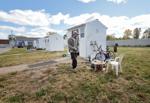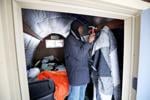In its most formidable undertaking but, the nonprofit Occupy Madison has bought property on the Far East Aspect to each construct tiny homes and find its third village of tiny dwellings for the homeless.
The nonprofit desires to construct properties and find its subsequent village of 20 to 30 tiny constructions at a 1-acre property with an 11,000-square-foot constructing, together with a basement in an industrial space, at 201-205 S. Stoughton Street.
“We have now an enormous want,” Occupy Madison co-president Brenda Konkel mentioned. “There are over 100 individuals on a ready checklist who’ve expressed curiosity within the tiny properties.”
Take an aerial tour of the finished homeless encampment at Dairy Drive in Madison in early November 2021, simply previous to moving-in.
However the proposal would require metropolis approvals, together with finding the tiny huts or homes in an space zoned for industrial use.
Persons are additionally studying…
“It is early days and never a whole lot of of us even find out about it, and the positioning is not technically in a neighborhood, however the preliminary reactions from a number of of us who shall be close by have been optimistic or no less than open to it,” mentioned Ald. Erik Paulson, whose third District contains the positioning. “For manufacturing tiny properties, the positioning is already industrial zoned, so Occupy Madison might get began on that in the present day. For residential makes use of, there are some actual downsides to this web site and an eventual rezoning is just not a certain factor.”
Occupy Madison opened its unique tiny home village on a small parcel that when held an auto restore store at 304 N. Third St. on the East Aspect in 2015. The positioning now has eight, 98-square-foot, everlasting tiny homes that now value about $10,000 apiece with exterior privateness fence, landscaping, and the restore store transformed to a typical space with restrooms, showers, kitchen , workshops and a retailer promoting handcrafted objects made by residents. There’s a greenhouse and huge, raised-bed gardens. A ultimate ninth home shall be added by spring.
In December 2020, the nonprofit opened its second village, a group of 28 Conestoga-style tiny huts — basically wood platforms coated by insulated cloth stretched over hoops recalling a coated wagon, which value lower than $2,500 apiece — on the former Wiggie’s Bar property on the former Wiggie’s Bar property at 1901 Aberg Ave., additionally on the East Aspect.

Conestoga-style huts have been positioned and leveled in preparation for occupants to maneuver in on the Occupy Madison tiny home village at 1901 Aberg Ave. in December 2020.
AMBER ARNOLD, STATE JOURNAL ARCHIVES
The property was renovated to incorporate a laundry, two bathe rooms, a kitchen and exterior fence and electrical energy for the huts. This spring, Occupy Madison will full a transition from blacktop parking heaps to landscaping, put together the entrance space for a espresso/sandwich cart, and proceed preparations to have 22 everlasting tiny homes to exchange the Conestoga huts.
On account of largely non-public fundraising supplemented by metropolis and Dane County grants, Occupy Madison owns each properties outright with no mortgage and has fully paid off renovations, which is essential as a result of it lowers working prices to lower than $100,000 yearly, Konkel mentioned.
“We generate income from our present retailer — crafts and wooden merchandise — an annual plant sale, annual vacation sale and different fundraising actions,” she mentioned.

“We have now been capable of present housing for over 60 individuals all through the time we have now owned the properties — a few of whom have moved into housing, reunited with households, gotten into remedy and moved on to different nice alternatives,” she mentioned. “So far as we all know, solely two individuals have returned to homelessness. Sadly, two individuals have handed away.”
New alternative
Now, after two years of looking, Occupy Madison has bought the property at 201-205 S. Stoughton Street for $800,000. The constructing now holds two tenants, who can keep till the nonprofit can full its approval and zoning processes, Konkel mentioned.
The acquisition is smart as a result of Occupy Madison wants a location to construct extra everlasting tiny homes and there may be funding obtainable by means of the federal American Restoration Plan Act that will not be obtainable sooner or later, Konkel mentioned.
“If we get zoning, the county has proposed to buy the property from us, lease it again to us for 10 years for $10 a yr and on the finish of 10 years we are able to buy it for $20,” Konkel mentioned. “We additionally then would get a grant from the county for $500,000 to assist pay for renovations — kitchen, group house, showers, loos, laundry, fence, exterior electrical energy — and a brief workers particular person for a yr to assist us handle all these actions and volunteers.”

Metropolis workers have been conscious that Occupy Madison may purchase the positioning, which is zoned for industrial use and mirrored within the Complete Plan for continued long-term industrial land use, and shared considerations {that a} rezoning of the property to a district that might enable for residential use wouldn’t align with adopted plans, Planning Division director Heather Stouder mentioned.
The method to accommodate tiny properties as a residential use on this web site would contain a plan modification and a rezoning of the positioning from “Industrial-Restricted” prone to the “Tiny Home Village” zoning district, Stouder mentioned.
“By state regulation, rezoning must be in step with the adopted plans, and the plans for this space have this land use as industrial,” Paulson mentioned. “There’s actually not a extra inconsistent pairing of land use for residential than industrial. I am attempting to maintain an open thoughts however altering the plans is one thing that must be carried out rigorously to keep away from unintended penalties.”
Self-governed
If profitable, Occupy Madison intends to maneuver the Conestoga huts at 1901 Aberg Ave. to the brand new web site because it builds the brand new bigger wood homes for its second village. It additionally plans a second retailer, a farm stand and a bigger woodshop to create crafts for its shops on the third web site. Finally, the nonprofit would make tiny homes for the brand new web site, too.
“Every property has a possible money-making ingredient to help us in paying for the working prices of the property,” Konkel mentioned.

A Little Free Library shares the grounds of Occupy Madison’s unique tiny home village at 304 N. Third St.
JOHN HART, STATE JOURNAL ARCHIVES
“One factor I do not assume individuals understand is that our villages are self-governed — which means the individuals who reside there make the selections for the villages and are the first membership of our group,” he mentioned. “It is cooperative-style dwelling and whereas it is free, it is also a whole lot of work. And, it requires a whole lot of ability constructing, conferences and studying to get together with one another.”
It is unclear precisely when the Conestoga huts could be moved to the brand new web site or when tiny properties could possibly be positioned there, she mentioned.
Over a quarter-century, the long-lasting Frank Lloyd Wright-inspired constructing introduced superstar, swag, individuals and money.
Massive modifications will come subsequent yr as town approves a sweeping redesign of its bus system that may ship extra frequent service however make so…
A set of tasks championed by Black and Hispanic leaders are attracting unprecedented private and non-private help and guarantees to reimagine So…
The COVID-19 pandemic has meant unprecedented federal sources to help the homeless, and Madison is utilizing it in some ways. However what’s going to occur…
Design groups with worldwide renovations are providing impressed visions to remake the Lake Monona waterfront with ultimate proposals in a high-inter…
